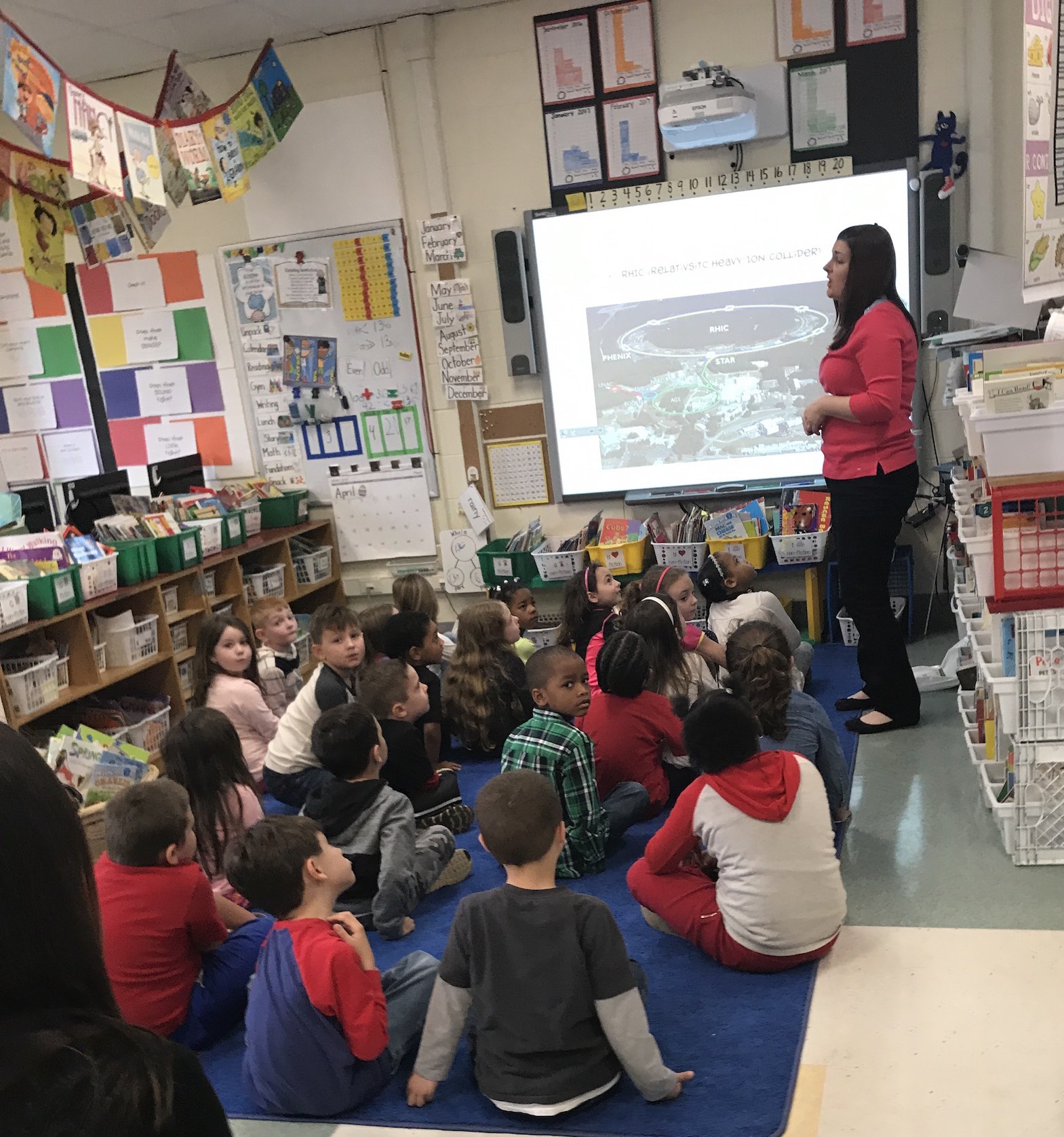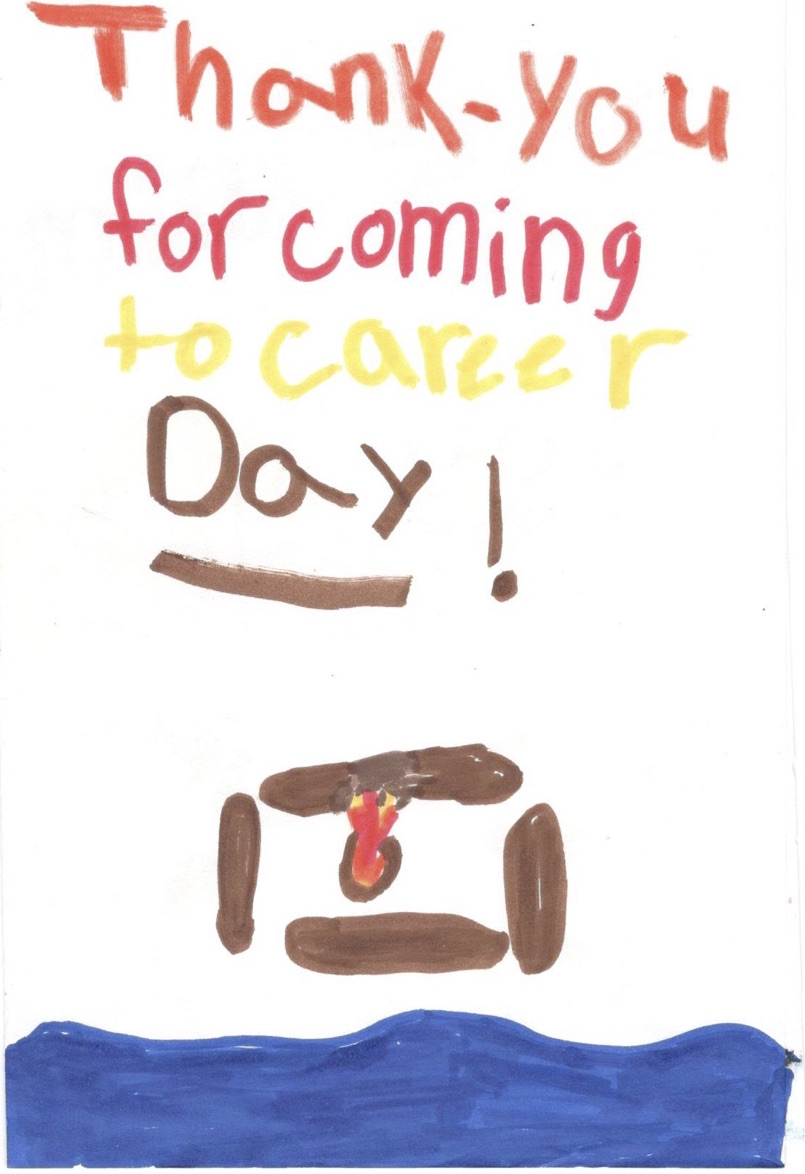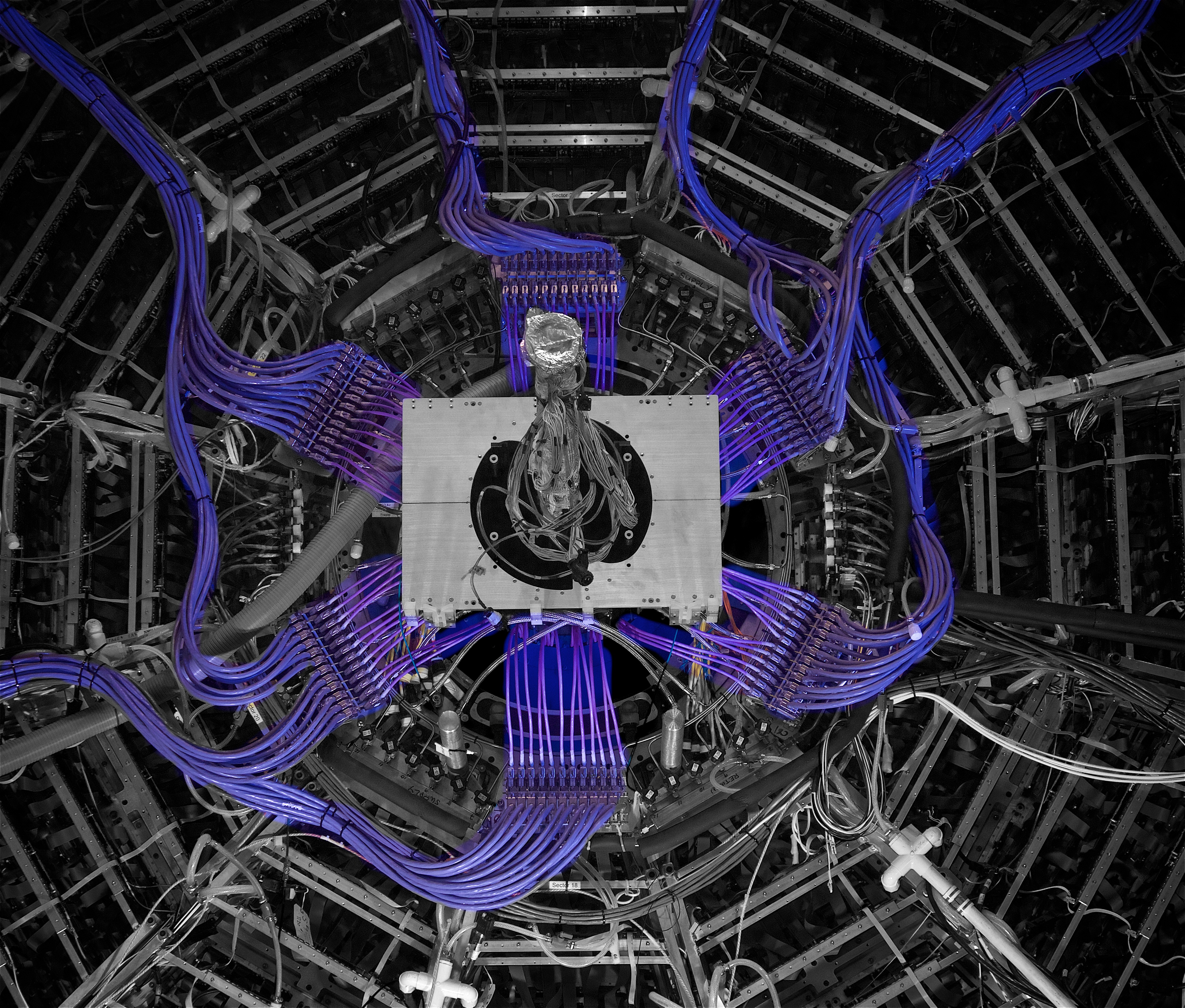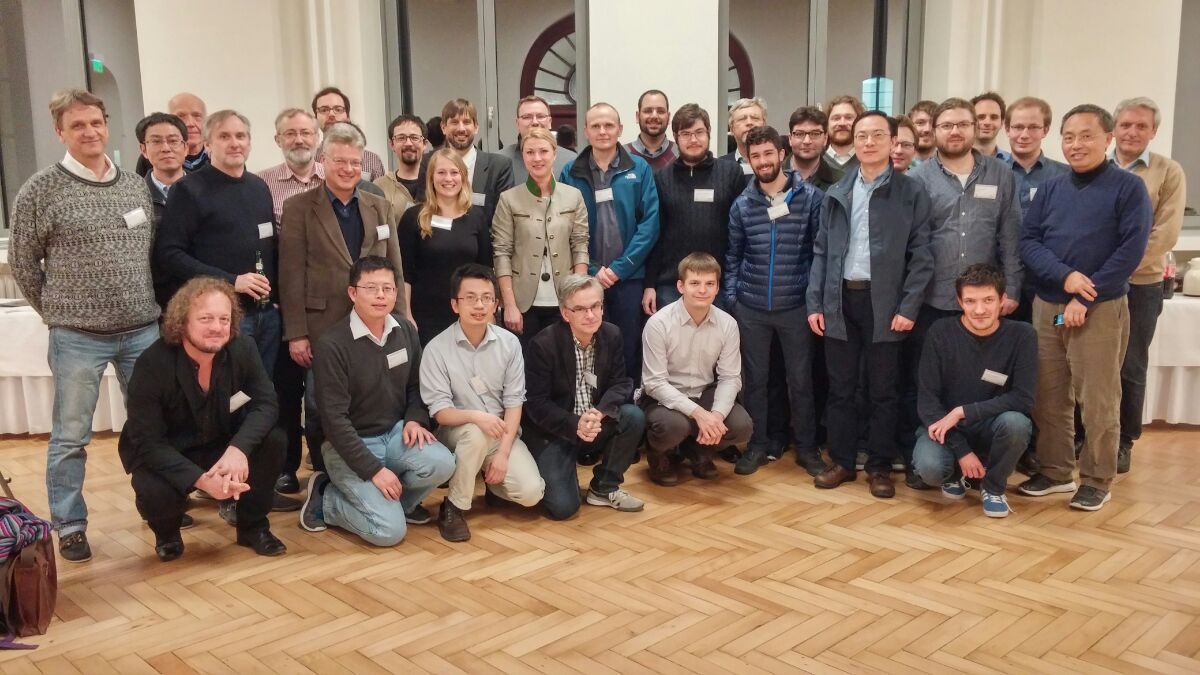April 2017
STAR Newsletter
April 2017 edition
Contents:- Λ Polarization
- Career Day: More Than Scientists
- From the Spokesperson
- CBM-STAR Joint Workshop in Darmstadt
- STAR arts
A note from the editor: as a collaboration-wide communication tool, this newsletter is set up to allow comments (subject to moderation against abuse), and all STAR Collaborators are welcome to do so! Please keep in mind that some content (including all comments) may be considered internal to the Collaboration and only accessible when logged into Drupal. Documentation is available here.

(Isaac Upsal - Student, OSU)
Non-central heavy ion collisions have angular momentum on the order of 1000h, and the resulting fluid may have a strong vortical structure important to the evolution of the system. This large vorticity is expected to polarize emitted baryons along the direction of system angular momentum through spin-orbit interactions in the medium (analogous to the Barnett effect). Such an alignment is "Global Polarization" and is distinct from the particle spin alignment with the production plane, as seen in p+p collisions. In this study we focus on (Λ)Λ baryons as their daughter (anti)proton emission direction follows a distribution centered (anti-)parallel to the spin direction of their parent.

Assuming a uniformly thermalized emission source the vorticity is a chemical potential which hadron spin couples to as a charge. Using this we can estimate the vorticity from the (Λ)Λ polarization (once feed-down is accounted for). Polarization of a few percent translates to a vorticity on the order of 1021 s-1, which far exceeds any extant measurements of physical systems (nanodroplets of superfluid 3He have ω ~ 107 s-1) earning heavy ion collisions a new superlative (most vortical!). Additionally the data hints at a larger polarization for Λ than for Λ baryons which may be an indication of spin coupling to the magnetic field left over by the sheared off spectators. Such a coupling would split the data as the magnetic moments of the Λ and Λ are of opposite sign, and it could be an exciting probe of the poorly understood magnetic field.
The polarization is non-exotic and non-chiral, but it may illuminate physics essential to chiral measurements. In particular STAR is investigating the Chiral Vortical Effect, a measurement of chiral current coupling to vorticity, and the Chiral Magnetic Effect, which is a measurement of chiral current coupling to a magnetic field. Both effects are difficult to measure, due to the complicated flow background, and difficult to theoretically estimate, due to the poorly constrained Chern-Simons number and the as-yet-unknown vorticity and magnetic field. Looking forward to BES II, detector upgrades and increased statistics will allow for a much more complete understanding of the polarization and its systematic dependencies which, at present, we do not have sufficient statistics to investigate in detail. Additionally this new data could support a statistically significant magnetic field measurement.

(Rachel Nieves - BNL)
On April 24th I had the privilege of being invited to my son's elementary school for Career Day. I was asked to give a presentation about my job. With the help of Helen Caines, Thomas Ullrich, and Kahille Dorsinvil of BNL's Stakeholders and Community Relations Office, I put together my presentation. The audience was kindergarten and 1st grade kids. It was so adorable! The questions they asked were so cute! One kid would put is all to shame with the knowledge he has in his head…some questions I couldn’t answer. We need to hire this 1st grader! The kids wrote Thank You cards and I received a certificate. It was truly a wonderful experience! My handout to everyone was the flyer for Summer Sundays. The kids seemed excited and wanted to come, so maybe we will see them in a few months.
My presentation began with how I started my career at BNL. I was 17 years old and a senior in high school and over the loud speaker they asked if anyone wanted a part time job at BNL assisting an administrator (secretary). Twenty years later I am still here at BNL and happy to be part of the BNL team.
I spoke to the kids about BNL's Science Learning Center (as most of them come here for field trips) and what a great opportunity they have by living so close that their school brings them here to learn science…physics, biology, chemistry...many options in the science world.
I then got into the group I work for, the STAR Experiment, and how it is part of the RHIC Project. I informed the students that scientists are trying to see what happens if you make something much hotter than the center of the sun. They are recreating how the universe looked before it was one second old (just after the Big Bang). At that time there were no planets or stars, it was just very, very hot! If we can understand how it looked then, we will understand better how it cooled down, and expanded, into what we see around us today.

- Coordinate domestic and foreign travel arrangements for group members and guests
- Make purchases with a BNL credit card
- Process web requisitions, shipping memos, contracts (guest appointment & yearly maintenance), and direct bills from outside companies
- Assist with budgets
- Process and maintain group publications
- Organize group reviews, meetings, and workshops
- Handle the phone bills, which entails making sure all records are correct (office numbers, service needs, person’s name connected to extension, etc.) and no abuse of phone usage is occurring
- Provide support to guests both foreign and domestic with navigating BNL's Guest Information System
I wanted the kids to see the entire picture that to work at BNL you don’t have to be a scientist. Yeah that is a great career path, but we are all a team at BNL. From the scientists, to the techs, to the admins we all work together to make experiments fully functioning units. I told the kids about how cool it has been for my son to come to where I work and partake in great events that BNL holds for the family members of its employees. I am proud of my career choice and how it has benefitted my family!
From the Spokesperson
(Zhangbu Xu - Spokesperson)
Three committees have been formed in the last month to review the forward upgrade proposal, to write the Beam Use Request and to form the May Collaboration meeting program. I would like to take this opportunity to thank all the committee members and chairs for their effort and contributions to STAR.
- A review committee on forward upgrade (chaired by Scott Wissink):
Dear Scott and ALL:
Thank you for agreeing to be on the review committee for STAR forward upgrade proposal.
We have proposed a forward upgrade in February 2017 (STARNote 0648).
This STAR internal committee is to review the merit, technology and readiness of the proposal. We will submit the updated proposal together with our 2017 BUR (separately) to PAC in May 15.
Given the budget constraints, the proponents have been very creative in arranging a cost-effective project and collaboration. The proposal is aimed to respond to PAC recommendation last year and a detailed implementation of the RHIC Cold QCD plan (arxiv:1602.03922). BNL ALD (Berndt Mueller) has requested presentations from both STAR and sPHENIX for this topic: “In addition, I invite the STAR and sPHENIX Collaborations to present letters of intent for proposals of modest forward upgrades to their detectors for data taking after 2021 for consideration by the PAC.” Clearly, it is important to highlight the strength of the STAR capabilities and uniqueness with the forward upgrade in connection with the mid-rapidity strength.
The highlighted recommendation from PAC is here.
“The PAC encourages the management and the collaborations to consider a potential (polarized) p+p and/or p+A program before 2023. In addition to the scientific benefits pointed out in the Cold QCD Report, this would help to keep the Cold QCD community active and engaged at RHIC, which might be important for the activities at BNL aiming at an EIC. It would also be helpful to further prioritize measurements by considering both the scientific impact as well as budget constraints. In this context we encourage the Cold QCD community to further elaborate the physics that can and must be done prior to EIC in order to aid in optimization of the future EIC science program.”
The committee members: Joern Putschke, Bill Llope, Declan Keane, Ken Barish, Saskia Mioduszewski, Jiangyong Jia, Anju Bhasin, Bernd Surrow, Yi Wang
Ex-Off: Ernst and Flemming
Sincerely,
Zhangbu Xu - Beam Use Request Writing Committee (chaired by Helen Caines and Zhangbu Xu)
Dear ALL:
I would like to invite you to be in the writing committee for the 2017 Beam Use Request.
Please see the attached call for the BUR from BNL ALD (Berndt Mueller). The major requests are outlined in the last year’s BUR with run 18 for isobar at 200GeV and AuAu at 27GeV and run 19 for first run of BES-II. The BUR should also make compelling cases for fixed-target program and detail the requested beam time and conditions.
A document on Cold QCD Plan and required upgrades will be submitted separately.
A rough outline of the responsibilities is as follows:
Zhangbu and Helen (co-chair)
Gang, Voloshin, Prithwish (Isobar for CME),
Grazyna, Geurts (BES-II),
Cebra, Herrmann (FXT),
Lisa, Xiaofeng (general),
Zhenyu, Gregory (HI accomplishments),
Renee, Oleg Eyser (Spin accomplishments),
Flemming, Rosi (Detector upgrades),
Jerome (software)
Please let me know if you would accept the invitation ASAP.
Sincerely,
Zhangbu - May Collaboration Meeting Program Committee (chaired by Xin Dong)
Dear ALL:
I would like to invite you to the program committee for the May Collaboration meeting to take place at BNL from May 15—20, 2017.
Proposed program committee for the May Collaboration meeting: Xin Dong (chair), Jim Drachenberg, Nihar Sahoo, Kathryn Meehan, Carl Gagliardi, Petr Chaloupka, Zilong Chang, Sedigheh Jowzaee, Chi Yang, Li Yi, Daniel Brandenburg
Ex-offico: Frank Geurts and Gene van Buren
Proposed outline of the program:
Junior day (Monday)
council meeting (Thursday)
Parallel sessions
Townhall meeting
Upgrade session
Preparation for BES-II
Isobar and CME physics
Spin program and toward EIC?
Physics working groups
Interested highlighted topics could be:
BES, CME, and forward upgrade (Cold QCD)
One of the possible topics related to BES-II would be fixed target and how we integrate that into the overall program (eTOF and other projects). I would suggest that we always have a talk from BEST collaboration.
Townhall meeting format will be similar to what we had at OSU. Topics could be: Spokesperson election, day-one BES-II physics, Programs at RHIC to Connections to EIC? This is an important task for the collaboration during this uncertain time. Please let me know if you would accept the invitation ASAP.
Sincerely,
Zhangbu Xu
For the STAR management team

Technische Universität Darmstadt Uhrturm (clock tower)
(Geary Eppley - Rice University
Tetyana Galatyuk - Technische Universität Darmstadt)
The STAR Collaboration and the Compressed Baryonic Matter Collaboration held a joint workshop in the historic art deco clock tower auditorium at the Technische Universität Darmstadt on Saturday March 18th. CBM and STAR are collaborating on an endcap time-of-flight detector for the Beam Energy Scan phase II at RHIC, scheduled for 2019-2020. The eTOF upgrade will greatly enhance the physics reach for BES-II and provide a full-scale integration and systems test for almost 10% of the planned CBM TOF system. The joint CBM-STAR project is part of the FAIR Phase 0 program to test detector components prior to the completion of CBM and the Facility for Antiproton and Ion Research accelerator at GSI Darmstadt, scheduled for 2025.
This first CBM-STAR joint workshop attracted 48 physicists from the US, China, and Europe. The sixteen presentations during the one-day Saturday session covered topics of interest for BES-II, CBM, and HADES from both an experimental and theory point of view. The conference web site can be found here. Contributions from STAR included presentations on the benefit of forward tracking for the fixed-target program from Zhenyu Ye, and on HLT plans from Hongwei Ke. Nu Xu, on behalf of Xiaofeng Luo, discussed expected improvements in fluctuation measurements. Daniel Brandenburg and Florian Seck presented the plans for dilepton measurements and recent theory developments, respectively. Frank Geurts discussed improvements and opportunities in bulk spectra. Isaac Upsal discussed the impact of BES-II on global hyperon polarization measurements. Daniel Cebra covered the fixed-target extension to BES-II and the benefits of the eTOF upgrade.
The workshop was delicious as well. The organizers provided a sumptuous Italian buffet for lunch and a traditional Hessian buffet Saturday evening. There was also a productive discussion session Sunday morning following the workshop. The CBM Collaboration meeting began Monday. Cebra presented the eTOF program in the FAIR Phase 0 plenary session. There was a construction readiness review of MRPC production for the eTOF modules. Yongjie Sun presented the USTC plans; Pengfei Lyu and Dong Han, the Tsinghua plans. Construction of the first batch, about 10% of the 108 MRPCs needed for the full eTOF, is scheduled to begin this May. A complete sector of eTOF, covering one TPC sector, will be installed at STAR for Run 18. The second CBM-STAR joint workshop is scheduled in conjunction with the next CBM collaboration meeting in Wuhan, September 25th-29th.
STAR arts
(Gene Van Buren - BNL)
This is a new feature we're trying with the STAR Newsletter for Collaborators to contribute something creative/artistic that relates to STAR. This could be a really cool looking graph generated from some analysis, or a striking photograph. The idea is akin to the "Back Scatter" feature of Physics Today (example), or the Picture of the Month of CERN Courier (example). Please feel free to have fun with this and consider making a contribution yourself for the next edition! We'll kick this off with a stylized photograph of STAR...

Wiring on the STAR endcap for the HFT viewed when STAR was rolled out into the Assembly Hall
Previous Edition: February 2017
Groups:
- Printer-friendly version
- Login or register to post comments

